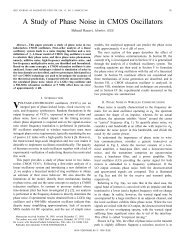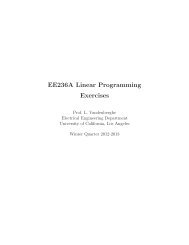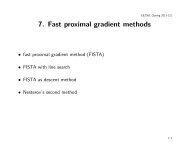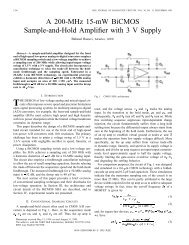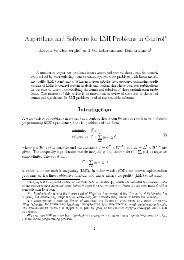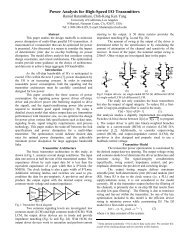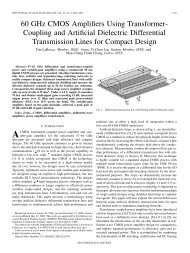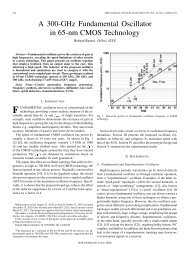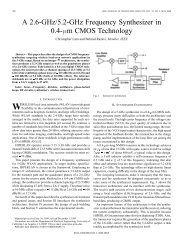9. Numerical linear algebra background
9. Numerical linear algebra background
9. Numerical linear algebra background
Create successful ePaper yourself
Turn your PDF publications into a flip-book with our unique Google optimized e-Paper software.
Convex Optimization — Boyd & Vandenberghe<br />
<strong>9.</strong> <strong>Numerical</strong> <strong>linear</strong> <strong>algebra</strong> <strong>background</strong><br />
• matrix structure and algorithm complexity<br />
• solving <strong>linear</strong> equations with factored matrices<br />
• LU, Cholesky, LDL T factorization<br />
• block elimination and the matrix inversion lemma<br />
• solving underdetermined equations<br />
Matrix structure and algorithm complexity<br />
cost (execution time) of solving Ax = b with A ∈ R n×n<br />
• for general methods, grows as n 3<br />
• less if A is structured (banded, sparse, Toeplitz, . . . )<br />
flop counts<br />
• flop (floating-point operation): one addition, subtraction,<br />
multiplication, or division of two floating-point numbers<br />
• to estimate complexity of an algorithm: express number of flops as a<br />
(polynomial) function of the problem dimensions, and simplify by<br />
keeping only the leading terms<br />
• not an accurate predictor of computation time on modern computers<br />
• useful as a rough estimate of complexity<br />
<strong>Numerical</strong> <strong>linear</strong> <strong>algebra</strong> <strong>background</strong> 9–2<br />
9–1
vector-vector operations (x, y ∈ R n )<br />
• inner product x T y: 2n − 1 flops (or 2n if n is large)<br />
• sum x + y, scalar multiplication αx: n flops<br />
matrix-vector product y = Ax with A ∈ R m×n<br />
• m(2n − 1) flops (or 2mn if n large)<br />
• 2N if A is sparse with N nonzero elements<br />
• 2p(n + m) if A is given as A = UV T , U ∈ R m×p , V ∈ R n×p<br />
matrix-matrix product C = AB with A ∈ R m×n , B ∈ R n×p<br />
• mp(2n − 1) flops (or 2mnp if n large)<br />
• less if A and/or B are sparse<br />
• (1/2)m(m + 1)(2n − 1) ≈ m 2 n if m = p and C symmetric<br />
<strong>Numerical</strong> <strong>linear</strong> <strong>algebra</strong> <strong>background</strong> 9–3<br />
Linear equations that are easy to solve<br />
diagonal matrices (aij = 0 if i = j): n flops<br />
x = A −1 b = (b1/a11,...,bn/ann)<br />
lower triangular (aij = 0 if j > i): n 2 flops<br />
x1 := b1/a11<br />
x2 := (b2 − a21x1)/a22<br />
x3 := (b3 − a31x1 − a32x2)/a33<br />
.<br />
xn := (bn − an1x1 − an2x2 − · · · − an,n−1xn−1)/ann<br />
called forward substitution<br />
upper triangular (aij = 0 if j < i): n 2 flops via backward substitution<br />
<strong>Numerical</strong> <strong>linear</strong> <strong>algebra</strong> <strong>background</strong> 9–4
orthogonal matrices: A −1 = A T<br />
• 2n 2 flops to compute x = A T b for general A<br />
• less with structure, e.g., if A = I − 2uu T with u2 = 1, we can<br />
compute x = A T b = b − 2(u T b)u in 4n flops<br />
permutation matrices:<br />
aij =<br />
1 j = πi<br />
0 otherwise<br />
where π = (π1,π2,...,πn) is a permutation of (1,2,...,n)<br />
• interpretation: Ax = (xπ1 ,...,xπn )<br />
• satisfies A−1 = AT , hence cost of solving Ax = b is 0 flops<br />
example:<br />
⎡<br />
A = ⎣<br />
0 1 0<br />
0 0 1<br />
1 0 0<br />
⎤<br />
⎡<br />
⎦, A −1 = A T = ⎣<br />
0 0 1<br />
1 0 0<br />
0 1 0<br />
<strong>Numerical</strong> <strong>linear</strong> <strong>algebra</strong> <strong>background</strong> 9–5<br />
The factor-solve method for solving Ax = b<br />
• factor A as a product of simple matrices (usually 2 or 3):<br />
A = A1A2 · · ·Ak<br />
(Ai diagonal, upper or lower triangular, etc)<br />
• compute x = A −1 b = A −1<br />
k<br />
· · ·A−1<br />
2 A−1 1<br />
⎤<br />
⎦<br />
b by solving k ‘easy’ equations<br />
A1x1 = b, A2x2 = x1, . .., Akx = xk−1<br />
cost of factorization step usually dominates cost of solve step<br />
equations with multiple righthand sides<br />
Ax1 = b1, Ax2 = b2, ..., Axm = bm<br />
cost: one factorization plus m solves<br />
<strong>Numerical</strong> <strong>linear</strong> <strong>algebra</strong> <strong>background</strong> 9–6
LU factorization<br />
every nonsingular matrix A can be factored as<br />
A = PLU<br />
with P a permutation matrix, L lower triangular, U upper triangular<br />
cost: (2/3)n 3 flops<br />
Solving <strong>linear</strong> equations by LU factorization.<br />
given a set of <strong>linear</strong> equations Ax = b, with A nonsingular.<br />
1. LU factorization. Factor A as A = PLU ((2/3)n 3 flops).<br />
2. Permutation. Solve Pz1 = b (0 flops).<br />
3. Forward substitution. Solve Lz2 = z1 (n 2 flops).<br />
4. Backward substitution. Solve Ux = z2 (n 2 flops).<br />
cost: (2/3)n 3 + 2n 2 ≈ (2/3)n 3 for large n<br />
<strong>Numerical</strong> <strong>linear</strong> <strong>algebra</strong> <strong>background</strong> 9–7<br />
sparse LU factorization<br />
A = P1LUP2<br />
• adding permutation matrix P2 offers possibility of sparser L, U (hence,<br />
cheaper factor and solve steps)<br />
• P1 and P2 chosen (heuristically) to yield sparse L, U<br />
• choice of P1 and P2 depends on sparsity pattern and values of A<br />
• cost is usually much less than (2/3)n 3 ; exact value depends in a<br />
complicated way on n, number of zeros in A, sparsity pattern<br />
<strong>Numerical</strong> <strong>linear</strong> <strong>algebra</strong> <strong>background</strong> 9–8
Cholesky factorization<br />
every positive definite A can be factored as<br />
with L lower triangular<br />
cost: (1/3)n 3 flops<br />
A = LL T<br />
Solving <strong>linear</strong> equations by Cholesky factorization.<br />
given a set of <strong>linear</strong> equations Ax = b, with A ∈ S n<br />
++ .<br />
1. Cholesky factorization. Factor A as A = LL T ((1/3)n 3 flops).<br />
2. Forward substitution. Solve Lz1 = b (n 2 flops).<br />
3. Backward substitution. Solve L T x = z1 (n 2 flops).<br />
cost: (1/3)n 3 + 2n 2 ≈ (1/3)n 3 for large n<br />
<strong>Numerical</strong> <strong>linear</strong> <strong>algebra</strong> <strong>background</strong> 9–9<br />
sparse Cholesky factorization<br />
A = PLL T P T<br />
• adding permutation matrix P offers possibility of sparser L<br />
• P chosen (heuristically) to yield sparse L<br />
• choice of P only depends on sparsity pattern of A (unlike sparse LU)<br />
• cost is usually much less than (1/3)n 3 ; exact value depends in a<br />
complicated way on n, number of zeros in A, sparsity pattern<br />
<strong>Numerical</strong> <strong>linear</strong> <strong>algebra</strong> <strong>background</strong> 9–10
LDL T factorization<br />
every nonsingular symmetric matrix A can be factored as<br />
A = PLDL T P T<br />
with P a permutation matrix, L lower triangular, D block diagonal with<br />
1 × 1 or 2 × 2 diagonal blocks<br />
cost: (1/3)n 3<br />
• cost of solving symmetric sets of <strong>linear</strong> equations by LDL T factorization:<br />
(1/3)n 3 + 2n 2 ≈ (1/3)n 3 for large n<br />
• for sparse A, can choose P to yield sparse L; cost ≪ (1/3)n 3<br />
<strong>Numerical</strong> <strong>linear</strong> <strong>algebra</strong> <strong>background</strong> 9–11<br />
Equations with structured sub-blocks<br />
A11 A12<br />
A21 A22<br />
x1<br />
x2<br />
<br />
=<br />
b1<br />
• variables x1 ∈ R n1 , x2 ∈ R n2 ; blocks Aij ∈ R ni×nj<br />
• if A11 is nonsingular, can eliminate x1: x1 = A −1<br />
11 (b1 − A12x2);<br />
to compute x2, solve<br />
(A22 − A21A −1<br />
11 A12)x2 = b2 − A21A −1<br />
11 b1<br />
Solving <strong>linear</strong> equations by block elimination.<br />
given a nonsingular set of <strong>linear</strong> equations (1), with A11 nonsingular.<br />
1. Form A −1<br />
11 A12 and A −1<br />
11 b1.<br />
2. Form S = A22 − A21A −1<br />
11 A12 and ˜ b = b2 − A21A −1<br />
11 b1.<br />
3. Determine x2 by solving Sx2 = ˜ b.<br />
4. Determine x1 by solving A11x1 = b1 − A12x2.<br />
<strong>Numerical</strong> <strong>linear</strong> <strong>algebra</strong> <strong>background</strong> 9–12<br />
b2<br />
<br />
(1)
dominant terms in flop count<br />
• step 1: f + n2s (f is cost of factoring A11; s is cost of solve step)<br />
• step 2: 2n 2 2n1 (cost dominated by product of A21 and A −1<br />
11 A12)<br />
• step 3: (2/3)n 3 2<br />
total: f + n2s + 2n 2 2n1 + (2/3)n 3 2<br />
examples<br />
• general A11 (f = (2/3)n 3 1, s = 2n 2 1): no gain over standard method<br />
#flops = (2/3)n 3 1 + 2n 2 1n2 + 2n 2 2n1 + (2/3)n 3 2 = (2/3)(n1 + n2) 3<br />
• block elimination is useful for structured A11 (f ≪ n 3 1)<br />
for example, diagonal (f = 0, s = n1): #flops ≈ 2n 2 2n1 + (2/3)n 3 2<br />
<strong>Numerical</strong> <strong>linear</strong> <strong>algebra</strong> <strong>background</strong> 9–13<br />
Structured matrix plus low rank term<br />
• A ∈ R n×n , B ∈ R n×p , C ∈ R p×n<br />
(A + BC)x = b<br />
• assume A has structure (Ax = b easy to solve)<br />
first write as A B<br />
C −I<br />
now apply block elimination: solve<br />
then solve Ax = b − By<br />
x<br />
y<br />
<br />
=<br />
b<br />
0<br />
(I + CA −1 B)y = CA −1 b,<br />
this proves the matrix inversion lemma: if A and A + BC nonsingular,<br />
(A + BC) −1 = A −1 − A −1 B(I + CA −1 B) −1 CA −1<br />
<strong>Numerical</strong> <strong>linear</strong> <strong>algebra</strong> <strong>background</strong> 9–14
example: A diagonal, B,C dense<br />
• method 1: form D = A + BC, then solve Dx = b<br />
cost: (2/3)n 3 + 2pn 2<br />
• method 2 (via matrix inversion lemma): solve<br />
then compute x = A −1 b − A −1 By<br />
(I + CA −1 B)y = CA −1 b, (2)<br />
total cost is dominated by (2): 2p 2 n + (2/3)p 3 (i.e., <strong>linear</strong> in n)<br />
<strong>Numerical</strong> <strong>linear</strong> <strong>algebra</strong> <strong>background</strong> 9–15<br />
Underdetermined <strong>linear</strong> equations<br />
if A ∈ R p×n with p < n, rankA = p,<br />
• ˆx is (any) particular solution<br />
{x | Ax = b} = {Fz + ˆx | z ∈ R n−p }<br />
• columns of F ∈ R n×(n−p) span nullspace of A<br />
• there exist several numerical methods for computing F<br />
(QR factorization, rectangular LU factorization, . . . )<br />
<strong>Numerical</strong> <strong>linear</strong> <strong>algebra</strong> <strong>background</strong> 9–16




